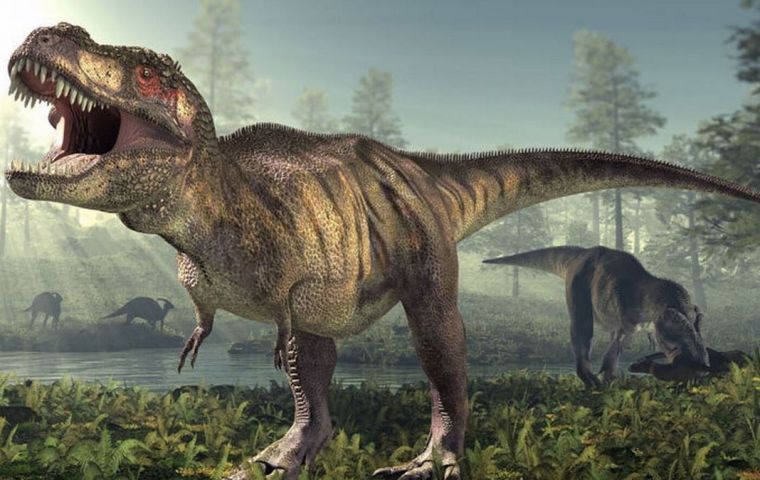MercoPress. South Atlantic News Agency
New species of Patagonian dinosaur described by scientists
 The project was supported by the National Geographic Society ad other sponsors from Argentina and the United States
The project was supported by the National Geographic Society ad other sponsors from Argentina and the United States The prestigious Current Biology journal Thursday carried a report on findings by Scientists in Argentina regarding a new giant carnivorous dinosaur found in the country, which has been named “Meraxes.”
”The importance of Meraxes lies in the fact that it is the first of the carcharodontosaurids (giant carnivorous dinosaurs) from the Americas to appear fairly complete,“ paleontologist Sebastián Apesteguía told Télam.
”Until now we had had problems with the others we found because they were very incomplete; for example, we didn't have a single skull to measure,” the National Council for Scientific and Technical Research (CONICET) and Azara Foundation expert went on.
Apesteguía was among the excavators of the project which started in 2012 following the discovery of the first bone remains and included four annual diggings.
“A complete skull and also the arms and legs of Meraxes were found, so we can have a lot of details of proportions and measurements and discuss the evolutionary process; for example, analyze why the dinosaurs with the largest skulls among carnivores have such small arms,” he added.
Apesteguía, who is also a teacher and author of numerous books, pointed out that “we were also able to prove that the internal claw of the three toes has grown to the point that it is double that of any other. This shows us that it used its feet as weapons, in addition to its head.”
Another of Meraxes' peculiarities is that ”thanks to paleohistology studies (microscopic analysis of the bones), we could see that it had lived about 45 years, which makes it one of the oldest dinosaur individuals we know because even the oldest known Tyrannosaurus rexes lived between 30 and 33 years.“
The new specimen is believed to have reached about 11 meters long and weighed over 4,200 kilograms; its head was huge, with bones heavily ornamented with protuberances, ridges, and grooves, and its teeth the size of knives, while its arms were like those of a human person.
”On its back it has a sort of indentation which probably corresponded to a rise in the line of vertebrae giving it a small hump. Its sacrum has a curious saddle-like shape and its legs were powerful,” Apesteguía described.
The bones of this new dinosaur were found in the Barda Atravesada de las Campanas, an arid site about 20 kilometers from Villa El Chocón, in the province of Neuquén. This area contains part of the rocks known as the Huincul Formation, deposited at the beginning of the Upper Cretaceous (about 96 to 93 million years old).
“The rocks of the Huincul Formation have long been known as a place where large dinosaur remains are found. We had been working in the north of Río Negro, where we discovered many new species of dinosaurs but small ones, and as a continuation of this work, we started to work in the south of Neuquén, where the Barda Atravesada de las Campanas is located. There we found Meraxes,” said the paleontologist.
The excavation was supported by the National Geographic Society and all the work was also financed by the Municipality of Villa El Chocón (Argentina), the Azara Foundation (Argentina), The Field Museum (USA), the R&D+i Agency (Argentina), and the National Science Foundation (USA).
“We found the first bones in 2012. At first, we expected it to be a Giganotosaurus carolini, which is from the area, but we discarded it because it is from an older period; then we thought it could be another of the giant carnivorous dinosaurs found in the Huincul Formation, but when preparing the specimen we realized that the bones were different,” he described.
The extraction of the large bones of this animal took four annual campaigns of two to four weeks each and involved the participation of researchers, technicians, and students.
The second part of the work consisted of preparing the skeleton, that is, cleaning the bones by removing the surrounding sandstone -- a process that took years.
The name Meraxes refers to one of the dragons in the story of the Game of Thrones series. “Relating dragons and dinosaurs has been going on for many years,” said Apesteguía.
The original fossil materials, as well as the rest of the fossils from the area, were deposited in the “Ernesto Bachmann” Municipal Museum of Villa El Chocón in Neuquén.
The researcher insisted that “we must separate the discovery from the publication of the work.”
“With Meraxes we started working in 2012, and two or three years later we realized that it was a new species, so what we take as the date is the publication of the work, which is what happened today,” he concluded.
(Source: Télam)




Top Comments
Disclaimer & comment rulesCommenting for this story is now closed.
If you have a Facebook account, become a fan and comment on our Facebook Page!